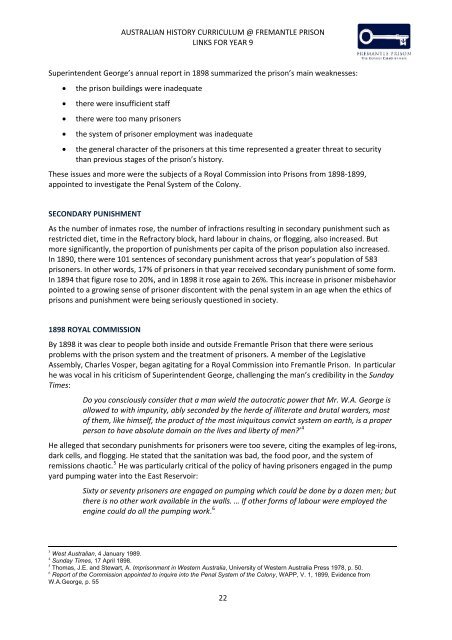planning a school excursion - Fremantle Prison
planning a school excursion - Fremantle Prison
planning a school excursion - Fremantle Prison
You also want an ePaper? Increase the reach of your titles
YUMPU automatically turns print PDFs into web optimized ePapers that Google loves.
AUSTRALIAN HISTORY CURRICULUM @ FREMANTLE PRISON<br />
LINKS FOR YEAR 9<br />
Superintendent George’s annual report in 1898 summarized the prison’s main weaknesses:<br />
• the prison buildings were inadequate<br />
• there were insufficient staff<br />
• there were too many prisoners<br />
• the system of prisoner employment was inadequate<br />
• the general character of the prisoners at this time represented a greater threat to security<br />
than previous stages of the prison’s history.<br />
These issues and more were the subjects of a Royal Commission into <strong>Prison</strong>s from 1898‐1899,<br />
appointed to investigate the Penal System of the Colony.<br />
SECONDARY PUNISHMENT<br />
As the number of inmates rose, the number of infractions resulting in secondary punishment such as<br />
restricted diet, time in the Refractory block, hard labour in chains, or flogging, also increased. But<br />
more significantly, the proportion of punishments per capita of the prison population also increased.<br />
In 1890, there were 101 sentences of secondary punishment across that year’s population of 583<br />
prisoners. In other words, 17% of prisoners in that year received secondary punishment of some form.<br />
In 1894 that figure rose to 20%, and in 1898 it rose again to 26%. This increase in prisoner misbehavior<br />
pointed to a growing sense of prisoner discontent with the penal system in an age when the ethics of<br />
prisons and punishment were being seriously questioned in society.<br />
1898 ROYAL COMMISSION<br />
By 1898 it was clear to people both inside and outside <strong>Fremantle</strong> <strong>Prison</strong> that there were serious<br />
problems with the prison system and the treatment of prisoners. A member of the Legislative<br />
Assembly, Charles Vosper, began agitating for a Royal Commission into <strong>Fremantle</strong> <strong>Prison</strong>. In particular<br />
he was vocal in his criticism of Superintendent George, challenging the man’s credibility in the Sunday<br />
Times:<br />
Do you consciously consider that a man wield the autocratic power that Mr. W.A. George is<br />
allowed to with impunity, ably seconded by the herde of illiterate and brutal warders, most<br />
of them, like himself, the product of the most iniquitous convict system on earth, is a proper<br />
person to have absolute domain on the lives and liberty of men?’ 4<br />
He alleged that secondary punishments for prisoners were too severe, citing the examples of leg‐irons,<br />
dark cells, and flogging. He stated that the sanitation was bad, the food poor, and the system of<br />
remissions chaotic. 5 He was particularly critical of the policy of having prisoners engaged in the pump<br />
yard pumping water into the East Reservoir:<br />
Sixty or seventy prisoners are engaged on pumping which could be done by a dozen men; but<br />
there is no other work available in the walls. … If other forms of labour were employed the<br />
engine could do all the pumping work. 6<br />
3<br />
West Australian, 4 January 1989.<br />
4<br />
Sunday Times, 17 April 1898.<br />
5<br />
Thomas, J.E. and Stewart, A. Imprisonment in Western Australia, University of Western Australia Press 1978, p. 50.<br />
6<br />
Report of the Commission appointed to inquire into the Penal System of the Colony, WAPP, V. 1, 1899, Evidence from<br />
W.A.George, p. 55<br />
22




